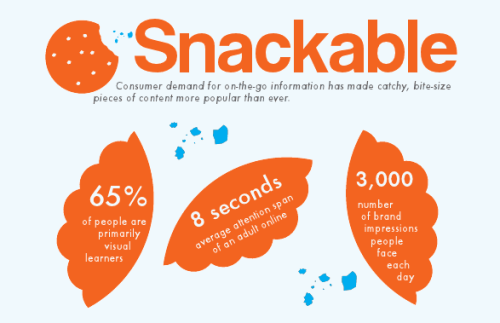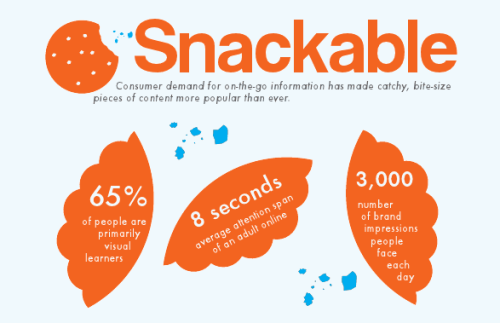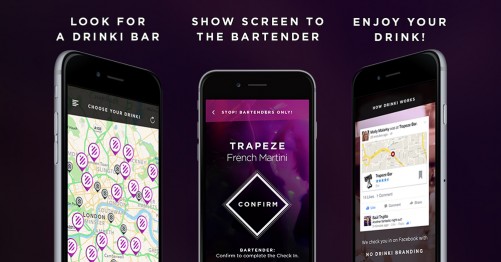


Mobile, wearables, snackable content changing the face of marketing




“Forrester predicts that by 2020, a fifth of all sales will be generated from info collected by mobile and wearable devices.”
see full quote on Visual.ly
Wearable devices include everything from smartphones to the Apple Watch; basically anything that can be carried on or attached to your person.
It seems every other day, someone produces a meme or infographic, depicting our wider selves as being ever more dependent on our phones and wearable devices. And, it seems that the trend is only set to continue, with innovations like the Apple Watch.
This will have huge implications on content marketing, seeing as most content/advertising will be viewed on phones, watches and tablets/iPads.
The type of content your audience will want to consume will change, making what marketing blogs call ‘snackable content’ more popular than medium or long length content.
‘Snackable content’ is short, bitesized content that you can literally ‘snack’ on while you’re on the move, Twitter and tweets are a good example of snackable content.
However, the increase in the use of wearable devices not only affects content, it will also affect advertising and sales.
This is where geographical location comes into play, take for example the ‘check in’ feature on Facebook. Person A ‘checks themselves in’ to a bar or a restaurant with their friends (usually with a mind-numbing and overly hash tagged update) and this, quite simply puts that bar or restaurant on the map.
For some years, restaurants and bars have had offers and discounts in conjunction with the ‘check in’ feature, stating ‘check in with us on Facebook and receive a free starter,’ and so on…
Why? Ultimately, because this feature is a way to get free advertising out to the rest of their potential target audience with little effort.
Other examples of this are the ‘boost’ feature on Facebook and the ‘promote’ feature on Twitter, which are examples of paid promotion that work particularly well when thinking about advertising to users dependent on wearable devices.
However, the marketing aspects of adapting to wearable devices are changing and the most obvious example of this, at the moment are GPS locators on wearable devices.
Open a new app on your smartphone and it will ask you if it can track your location, in order to bring you the most relevant information in your area.
As this is an optional extra when using an app, it’s not always a viable marketing option, however some apps are developed, specifically with geographical location in mind…
Take for example, Drinki: Drinki is an app (currently just for women) that offers you one free drink per day at a bar, in the city in which you are.
Much like Google Maps, the app drops a pin to your current location and Drinki then shows you the bars nearest to you and which bar has which drink offer for that day. You simply choose a bar, show the bar tender your phone and redeem your Drinki for the day.
Truly a result of the digital age, the interest here is for bars to sign up with the app to promote an offer and gain some extra advertising, as it is in Drinki’s best interest to promote the app as widely as possible.
Here you can see that this advertising is completely reliant on a wearable device, with a stress on geographical location, which could be of great benefit to you as a restaurant or bar owner.
Paying a small fee for the benefit of appearing on this app, is similar to paid social media advertising, on which all businesses are becoming more and more dependent.
Speaking of social media, Facebook are currently making a big noise on marketing and business blogs, thanks to their Place Tips innovation.
Place Tips again take note of your geographical location and suggest places that you might like to go to, based on your current needs.
Where this differs from the likes of Siri and Google, is that you don’t have to speak to Place Tips.
As a feature it gathers information about a business, i.e. posts from its page, its upcoming events and friends’ recommendations and check-ins, to then show it at the top of a user’s News Feed.
Again, this person is likely to be using this feature on a wearable device, rather than at a desktop or laptop.
Twitter do something similar by grouping together conversations and making suggestions of interesting exchanges to a user.
Although it may make some a little queasy to know that their movements are being GPS tracked, the fact is that your business marketing needs to adapt to the supernovae that are wearable devices.
Soon, it will be virtually impossible not to have a digital business in some form, and it seems that it will become a necessity to have paid social media marketing to build and maintain customer relationships/loyalty. Get down on it.
The times are changing, outbound is outdated and in some cases, can be potentially dangerous for your brand financially and in a reputational sense. Big fines are being handed out to serial data offenders. With inbound you can avoid this and get the best from your leads so read our blog “How to create Inbound Strategy Masterclass” for more information.”










